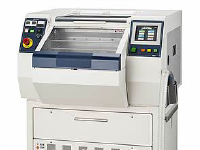
NEC Corporation announced the development of a control technology that doubles the efficiency of autonomous mobile robots (AMR) in warehouses while maintaining a high level of safety. NEC plans to put this technology into practical use by March 2024 and to have it installed in NEC’s cooperative AMRs in Japan.
In recent years, the introduction of robots for transporting materials has accelerated due to labor shortages and large warehouses. However, even when robots have been introduced to automate transport work, it has been necessary to reduce traveling speed to ensure safety, and the improvement of transport efficiency has become a challenge. Since it has been necessary to construct passageways and areas dedicated to mobile robots in order accelerate speed while ensuring safety, it has been difficult to introduce robots into existing warehouses.
As a result, robots can autonomously determine when to travel at high speed, and over the shortest distances, such as when traveling in low risk locations without workers, objects on the floor or other obstacles. Conversely, robots will travel at a low speed when using routes that are determined to be high risk locations. When comparing transport work between a robot applying this technology and a conventional robot, it was confirmed that the work time was halved and the transfer efficiency could be doubled while ensuring safety. In addition, safety and efficiency can be achieved without dedicated robot areas, making it easy to install in existing warehouses.
Also read: “China, Japan & US controls 60% of global installations of industrial robots“
Hiroshi Yoshida, Senior Principal Researcher in System Platform Research Laboratories explains risk-sensitive stochastic control technology can enable a high level of both safety and efficiency in robot control. For example, in the case of the AGVs (Automatic Guided Vehicles) that we are developing for use in warehouses, ensuring safety by preventing contact with people and objects is a prerequisite for introducing the robot in the front line. However, if the AGV is too slow or pauses too many times to ensure safety, its efficiency will decrease and it will be useless as a robot. Since logistics warehouses are in a harsh work environment where profits are based on the number of units transported per hour, the pursuit of throughput is also extremely important. risk-sensitive stochastic control was developed as a technology that is useful for this type of situation. Compared to conventional AGVs, AGVs equipped with this technology can almost double their average speed without compromising safety. This means that the efficiency is approximately doubled.
On the other hand, the speed can be slowed on hazardous narrow roads for avoiding collisions. In our experiments, the conventional AGV collided with the surrounding wall 9 out of 10 times, while the AGV equipped with the new technology was able to pass through a narrow road with sharp turns without hitting the wall even once. This is why we feel that this technology will enable high-level avoidance of collisions and contact with surrounding people and objects. The cost for adopting this technology can be kept low because there is no need to prepare a dedicated transport path for the robot.
In fact, the technology itself, risk-sensitive stochastic control, has been around for some time. It has been used in the world of mathematical finance. Since the risk of “bankruptcy” should be absolutely avoided in asset management, it has been used as a means to maximize profits while avoiding high-risk investments. The key point of our current research and development is that we were able to apply this technology to the field of real-time robot control and implement it as a technology that maximizes efficiency while avoiding the worst risk of “collision.”
In addition to my expertise in mechanics and robotics, Dr. Yasuda, who had been working on quantum statistical mechanics, was in charge of the software, and Mr. Kumagai, who is an expert on networks, was in charge of robot implementation and hardware. I believe that this technology was developed by each of us drawing from our unique fields of expertise.


















